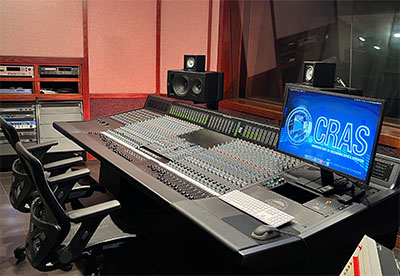Among the leading audio education institutions in the US, Arizona’s Conservatory of Recording Arts & Sciences (CRAS) has installed two Solid State Logic Origin 32-channel in-line analogue mixing consoles – one in Studio B at the main CRAS campus in Tempe and the other in Studio B at the satellite campus in Gilbert.
‘Students have access to both consoles,’ says Robert Brock, Director of Education. ‘On any given day, we’re running the same class at both locations in parallel.’
 The consoles replace a pair of 25-year-old consoles that were used by CRAS teaching staff to instruct students on the concepts of audio signal flow and the features and functionality of analogue consoles. ‘We didn’t see any need to change the core concepts of the training, so it was just about what piece of equipment helps us illustrate those concepts well, that is new and that is going to be reliable,’ Brock says.
The consoles replace a pair of 25-year-old consoles that were used by CRAS teaching staff to instruct students on the concepts of audio signal flow and the features and functionality of analogue consoles. ‘We didn’t see any need to change the core concepts of the training, so it was just about what piece of equipment helps us illustrate those concepts well, that is new and that is going to be reliable,’ Brock says.
Having taught on four SSL consoles – two 4000 Series and two AWS 948s, in other rooms – CRAS selected the newest large-format console from the same source.
‘The Origin sounds good; it’s a pro-level console,’ Brock says. ‘It’s an SSL – whether it’s a small interface or a large-format console, SSL is not going to put out something that doesn’t sound great.’
‘A core concept of CRAS on a technical level, when we’re training a student to be a professional, is to think in terms of signal flow more than anything else,’ Brock continues. ‘If you can understand signal flow you can navigate your way through almost any situation. We’re big believers in teaching it from an analogue standpoint, because it’s easier to see, touch, grab and feel, which we have always felt is helpful for our students. They can visualize the signal flow even when they move into DAW-based environments.’
And since the new consoles were installed, CRAS instructors have found their jobs a little simpler: ‘The instructors that teach this console fundamentally feel it’s an easier console to teach. It allows us to get to the core concept of what we’re trying to teach relatively easily – easier than it was before,’ Brock says. ‘We feel like the Origin really allows us to get to those core concepts with little confusion.’
SSL developed the Origin for modern hybrid music production workflows – which is what CRAS teaches using Pro Tools and two-inch analogue tape machines. ‘Students may not go on to work with tape machines after graduation, but they’re going to be in DAW-based environments that mimic a lot of that, or even specifically emulate it, and they will have that mental library,’ Brock says.
Origin has become a popular choice at commercial studios as well as educational institutions worldwide. ‘Students may go and intern at a studio – because a requirement for graduation at CRAS is an internship – that’s running this specific console. So it’s nice to see Origin’s install base,’ Brock says.
At a quarter-century old, the old desks were also no longer representative of modern mixing. ‘What’s nice about Origin is that it is a modern desk,’ Brock adds. ‘It’s a console that SSL obviously decided there was a market for because people are still using that more traditional workflow in tandem with modern DAWs. It allows us to teach and give students the opportunity to see a hybrid DAW/analogue workflow, which is what we were doing before in the rooms. So that’s another thing that we liked about the Origin.’
The traditional in-line analogue signal path of the previously installed consoles served an educational purpose. ‘It’s where students learned the small fader/large fader concept, routing, how to subgroup, how to build headphone cues – all these basic principles of mixing,’ Brock says. He notes that Origin’s fader, switch and knob layout demonstrates those same concepts using slightly different and easier to understand, terminology.
CRAS has had sidecars fitted at each end of both Origins that match the consoles’ profile and offers integrated 19-inch rack space. ‘It was a total custom build. We had a guy come in and 3D-scan the side of the console. We teach the use of patchbays, so there is a patchbay in there, and we’re loading up some additional equipment into the sidecars, including 500 series modules,’ Brock says. ‘I also dig the flexibility of Origin’s centre section, where you can add equipment. We have plans to also load that up.’
More: www.solidstatelogic.com














